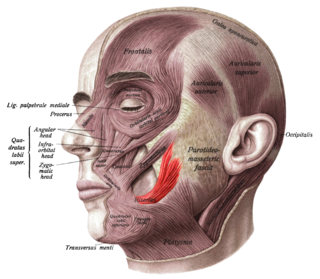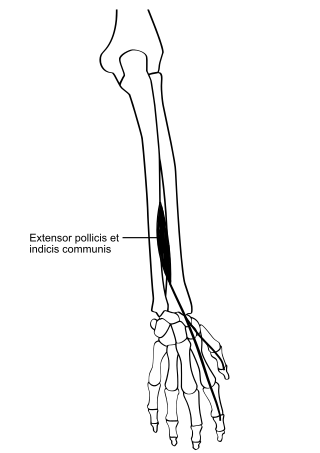Related Research Articles
Zoology is the scientific study of animals. Its studies include the structure, embryology, classification, habits, and distribution of all animals, both living and extinct, and how they interact with their ecosystems. Zoology is one of the primary branches of biology. The term is derived from Ancient Greek ζῷον, zōion ('animal'), and λόγος, logos.

The brachialis is a muscle in the upper arm that flexes the elbow. It lies beneath the biceps brachii, and makes up part of the floor of the region known as the cubital fossa. It originates from the anterior aspect of the distal humerus; it inserts onto the tuberosity of the ulna. It is innervated by the musculocutaneous nerve, and commonly also receives additional innervation from the radial nerve. The brachialis is the prime mover of elbow flexion generating about 50% more power than the biceps.

Vestigiality is the retention, during the process of evolution, of genetically determined structures or attributes that have lost some or all of the ancestral function in a given species. Assessment of the vestigiality must generally rely on comparison with homologous features in related species. The emergence of vestigiality occurs by normal evolutionary processes, typically by loss of function of a feature that is no longer subject to positive selection pressures when it loses its value in a changing environment. The feature may be selected against more urgently when its function becomes definitively harmful, but if the lack of the feature provides no advantage, and its presence provides no disadvantage, the feature may not be phased out by natural selection and persist across species.

A head is the part of an organism which usually includes the ears, brain, forehead, cheeks, chin, eyes, nose, and mouth, each of which aid in various sensory functions such as sight, hearing, smell, and taste. Some very simple animals may not have a head, but many bilaterally symmetric forms do, regardless of size.

Male is the sex of an organism that produces the gamete known as sperm, which fuses with the larger female gamete, or ovum, in the process of fertilisation. A male organism cannot reproduce sexually without access to at least one ovum from a female, but some organisms can reproduce both sexually and asexually. Most male mammals, including male humans, have a Y chromosome, which codes for the production of larger amounts of testosterone to develop male reproductive organs.

The risorius muscle is a highly variable muscle of facial expression. It has numerous and very variable origins, and inserts into the angle of the mouth. It receives motor innervation from branches of facial nerve. It may be absent or asymmetrical in some people. It pulls the angle of the mouth sidewise, such as during smiling.

In human anatomy, the supinator is a broad muscle in the posterior compartment of the forearm, curved around the upper third of the radius. Its function is to supinate the forearm.

In human anatomy, the palmar or volar interossei are four muscles, one on the thumb that is occasionally missing, and three small, unipennate, central muscles in the hand that lie between the metacarpal bones and are attached to the index, ring, and little fingers. They are smaller than the dorsal interossei of the hand.
Stuart Alan Newman is a professor of cell biology and anatomy at New York Medical College in Valhalla, NY, United States. His research centers around three program areas: cellular and molecular mechanisms of vertebrate limb development, physical mechanisms of morphogenesis, and mechanisms of morphological evolution. He also writes about social and cultural aspects of biological research and technology.
Life history theory (LHT) is an analytical framework designed to study the diversity of life history strategies used by different organisms throughout the world, as well as the causes and results of the variation in their life cycles. It is a theory of biological evolution that seeks to explain aspects of organisms' anatomy and behavior by reference to the way that their life histories—including their reproductive development and behaviors, post-reproductive behaviors, and lifespan —have been shaped by natural selection. A life history strategy is the "age- and stage-specific patterns" and timing of events that make up an organism's life, such as birth, weaning, maturation, death, etc. These events, notably juvenile development, age of sexual maturity, first reproduction, number of offspring and level of parental investment, senescence and death, depend on the physical and ecological environment of the organism.

The Helicis minor is a small skeletal muscle. The helicis minor is an intrinsic muscle of the outer ear. The muscle runs obliques and covers the helical crus, part of the helix located just above the tragus.

The helicis major is an intrinsic muscle of the outer ear.
The posterior compartment of the forearm contains twelve muscles which primarily extend the wrist and digits. It is separated from the anterior compartment by the interosseous membrane between the radius and ulna.

Evolutionary physiology is the study of the biological evolution of physiological structures and processes; that is, the manner in which the functional characteristics of organisms have responded to natural selection or sexual selection or changed by random genetic drift across multiple generations during the history of a population or species. It is a sub-discipline of both physiology and evolutionary biology. Practitioners in the field come from a variety of backgrounds, including physiology, evolutionary biology, ecology, and genetics.

Ian Tattersall is a British-born American paleoanthropologist and a curator emeritus with the American Museum of Natural History in New York City, New York. In addition to human evolution, Tattersall has worked extensively with lemurs. Tattersall is currently working with the Templeton Foundation.

A hand is a prehensile, multi-fingered appendage located at the end of the forearm or forelimb of primates such as humans, chimpanzees, monkeys, and lemurs. A few other vertebrates such as the koala are often described as having "hands" instead of paws on their front limbs. The raccoon is usually described as having "hands" though opposable thumbs are lacking.
The Extended Evolutionary Synthesis (EES) consists of a set of theoretical concepts argued to be more comprehensive than the earlier modern synthesis of evolutionary biology that took place between 1918 and 1942. The extended evolutionary synthesis was called for in the 1950s by C. H. Waddington, argued for on the basis of punctuated equilibrium by Stephen Jay Gould and Niles Eldredge in the 1980s, and was reconceptualized in 2007 by Massimo Pigliucci and Gerd B. Müller.

In human anatomy, the extensor pollicis et indicis communis is an accessory muscle in the posterior compartment of forearm. It was first described in 1863. The muscle has a prevalence from 0.5% to 4%.

Social selection is a term used with varying meanings in biology.
In biology, constructive development refers to the hypothesis that organisms shape their own developmental trajectory by constantly responding to, and causing, changes in both their internal state and their external environment. Constructive development can be contrasted with programmed development, the hypothesis that organisms develop according to a genetic program or blueprint. The constructivist perspective is found in philosophy, most notably developmental systems theory, and in the biological and social sciences, including developmental psychobiology and key themes of the extended evolutionary synthesis. Constructive development may be important to evolution because it enables organisms to produce functional phenotypes in response to genetic or environmental perturbation, and thereby contributes to adaptation and diversification.
References
- ↑ "Rui Diogo Amazon Author profile". amazon.com. Retrieved December 28, 2021.
- ↑ "Rui Diogo Research Laboratory". ruidiogolab.org. Retrieved January 3, 2022.
- ↑ "Babies in the womb have lizard-like hand muscles - BBC News". BBC News. October 2019. Retrieved October 21, 2019.
- ↑ Diogo, R.; Siomava, N.; Gitton, Y. (2019). "250-million-year-old evolutionary remnants seen in muscles of human embryos | EurekAlert! Science News". Development. 146 (20). Eurekalert.org. doi: 10.1242/dev.180349 . PMID 31575609 . Retrieved October 21, 2019.
- ↑ "Babies have lizard-like hand muscles in womb, scientists say | London Evening Standard". Standard.co.uk. October 1, 2019. Retrieved October 21, 2019.
- ↑ Jack Hardy (October 1, 2019). "Babies have 'lizard hands' in the womb but lose muscles before they are born, study claims". Telegraph.co.uk. Retrieved October 21, 2019.
- ↑ Dols, José Miguel Fernández; Russell, James Albert (2017). The Science of Facial Expression. Oxford University Press. ISBN 978-0-19-061350-1.
- ↑ Sánchez-Villagra, Marcelo R. (2018). "Evolution Driven by Organismal Behavior: A Unifying View of Life, Function, Form, Mismatches and Trends". Swiss Journal of Palaeontology . 137: 109–112. doi:10.1007/s13358-017-0139-4.
- ↑ "Rui Diogo Research Lab profile". ruidiogolab.org. Retrieved December 28, 2021.
- ↑ "HOME ANATOMY FACULTY FACULTY PROFILES". medicine.howard.edu. Retrieved December 28, 2021.
- ↑ Baas, Jeroen; Boyack, Kevin; Ioannidis, John P. A. (2020). "Bibliometrics". Data for "Updated science-wide author databases of standardized citation indicators". Vol. 2. elsevier.digitalcommonsdata.com. doi:10.17632/btchxktzyw.2 . Retrieved December 28, 2021.
- 1 2 Smulders, Tom V. (2017). "Evolution Driven by Organismal Behaviour – a Unifying View of Life, Function, Form, Mismatches, and Trends". Journal of Anatomy. 232 (2): 356–357. doi: 10.1111/joa.12750 . PMC 5770302 .
- ↑ "Evolution Driven by Organismal Behavior". extendedevolutionarysynthesis.com. Retrieved 10 November 2023.
- ↑ Fleagle, John G. (2017). "Evolution Driven by Organismal Behavior: A Unifying View of Life, Function, Form, Mismatches, and Trends". The Quarterly Review of Biology. 92 (4): 469. doi:10.1086/694961.